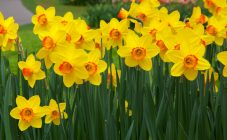Content:
Daffodils are flowers that, despite their name, are very unpretentious when grown in the garden. However, after they have faded, they need some care. This is necessary so that next year the daffodils will delight the gardener with lush flowering, otherwise the flowers may lose their varietal properties. Caring for daffodils after flowering is uncomplicated and unobtrusive. Its features will be discussed later in this article.
When daffodils bloom
What do they do with daffodils after they have faded?
There are quite a few types of daffodils, which may differ from each other in height, foliage shape, flower color. The same applies to the timing of flowering: there are early varieties, there are later ones. And, despite the fact that the daffodil is predominantly a spring flower, its flowering is directly influenced by the climate of the area in which it grows and the weather conditions in a particular season.
So, in central Russia, where these flowers, along with tulips, are the first to delight with their flowering after a long and cold winter, daffodils can bloom as early as late April or early May. For the southern regions of the country, the budding period is postponed to an earlier date. For example, already at the beginning of April, southerners' homesteads are decorated with blossoming daffodil flowers. And, on the contrary, in the northern regions, the plant blooms in early summer, when the air and earth are warm enough (in early or mid-June).
But daffodils do not please the eyes for long. On average, they have a flowering period of about 2 weeks. Of course, a lot depends on the variety. For example, the daffodil Martha Washington blooms on the strength of 8-9 days, and the Agathon variety flaunts with lemon-yellow flowers for 3 weeks. However, this is a fairly short period. This lack of daffodils is compensated for by the fact that they bloom very early, almost immediately after the snow melts, and besides, caring for them is not at all burdensome.
After the daffodils have faded, only foliage remains, which wilts with the arrival of autumn, when the growing season of these plants comes to an end.
Thus, daffodils bloom in late spring or early summer, depending on the variety and growing area.
Daffodils have faded: what to do next in the open field
How to care for daffodils after flowering? In order for them to grow well, and their growth was accompanied by lush and abundant flowering, they need to be taken care of in a peculiar way. In this case, special skills are not required, since the events are simple and not burdensome for the grower.
So, the daffodils have faded, what do they do with them? During the flowering period, the plant only needs to be watered occasionally, if necessary. After the daffodils have faded, it is not recommended to process their foliage in any way for about 2 months. The fact is that, despite the absence of flowers, the growing season continues. The plant receives nutrients from the soil and develops further. It is through the foliage that daffodils receive sunlight. Removing it too early can damage the plant. However, if daffodils are growing in a flower bed, then it must be pruned periodically to avoid overgrowth.
Fertilizers are also applied in the fall. As a top dressing you can use:
- compost;
- humus;
- phosphorus;
- potassium.
If daffodils grow on the site, care after flowering in open ground also involves working with bulbs. If the gardener decided not to dig them out, but leave them to winter in the soil, then you need to cover the place where mulch grows. As it is well suited:
- peat;
- sawdust;
- humus;
This is especially important for young plants, where the bulbs can be damaged by the cold. However, in areas with a warm climate, mulching is not necessary.
Many gardeners are thinking: should they dig up daffodil bulbs in the fall? It should be noted that this should not be done often. So, young bulbs should not be dug out, they are quite capable of overwintering in the ground, it is enough just to cover it with a layer of mulch. However, adult specimens still need to be dug up. This is due, first of all, to the fact that they grow rather quickly, forming many children. It is recommended to dig up the plant for 3 years after planting. The optimal period for this is August or September, that is, when the growing season for daffodils ends.
Separately, it should be said about plant transplantation. You should not do this every year, as this procedure, carried out too often, can lead to the fact that the daffodils simply stop blooming in a new place. If not necessary, then replanting them is not necessary at all. However, signs that the plant can no longer grow in its old place can be:
- small inflorescences;
- no flowering for more than 2 consecutive seasons;
- severe damage by pests and diseases.
When digging and storing the bulbs, certain rules and technology should be followed so as not to accidentally damage them.
So, the bulbs should be removed from the ground using a well-sharpened shovel. Dig deep to avoid damaging the bulbs. Also, immediately after they are removed to the surface, they should be taken to a dark room. Exposing the bulbs to direct sunlight can damage them. To avoid spoiling them, you should not separate the children immediately after digging, it is better to do this when they dry out a little.
Transplanting daffodils is best done in the fall, 2-3 weeks before frost. Specific dates depend on the weather conditions in a particular region. You should not transplant daffodils to a place close to the old one. To plant the bulbs, it is worth digging small holes 5-6 cm deep in the ground. The distance between them should not be less than 8 cm. Then the bottom of the holes must be watered. In each depression, one onion is laid, which is covered with earth. After the garden bed, it is worth mulching.
Tips and tricks from experienced florists and gardeners
Daffodils are so popular among Russian gardeners that seasoned summer residents have a whole arsenal of tricks and useful tips for caring for these plants. Daffodils after flowering, what do experienced gardeners do with them?
Many growers still advise not to dig out even young bulbs unnecessarily, but to mulch. In addition to the above-mentioned products used as mulch, many of them use fallen leaves for this. They perfectly retain heat, preventing the bulbs from freezing even in the coldest winters.
- After cutting the foliage, you should not throw it away, it is better to leave it near the place of growth. This will help you quickly find the location of the bulbs when replanting is necessary.
- When digging up daffodils, do not throw out wounded (damaged) children.They can be sprinkled with wood ash and left to be stored in a dry, warm and separate place. Most of them may be quite viable.
- Narcissus bulbs are poisonous to humans, so experienced gardeners must take precautions when working with them. It is obligatory to use rubber gloves and wash hands with laundry soap at the end of the corresponding manipulations.
- If daffodils have been growing in one place for more than 6 years and have never been dug up, then their root system grows significantly. To work with such plants, you should not use ordinary garden tools, but a large-sized shovel, which will significantly reduce labor intensity and time.
- Before removing the daffodil bulbs for storage, you need to treat them with a weak solution of potassium permanganate. This will save them from the harmful effects of pathogenic microorganisms and kill the pests that have settled in them.
- Bulbs should not be stored in bags, bags without fresh air. They can simply rot from it.
- During storage, the bulbs should be periodically inspected for the appearance of rot. A damaged copy should be weeded out from healthy ones.
- In the room where the daffodils are stored, air must be circulated. If for some reason this is not possible, then a regular fan will come to the rescue, which is recommended to be periodically used in the storage.
- Before planting, in order to avoid damage to the bulbs by pests, they should be treated in a karbofos solution, even though they may visually look completely healthy.
Despite the ease of caring for daffodils after flowering, it is a very important part of growing and breeding them. With proper care of the plants and the observance of the relevant rules of agricultural technology, from year to year they will delight the gaze of the gardener with delicate and fragile spring flowers.















